Subfamily Amiinae Scientific name Amia calva Higher classification Amia | Phylum Chordata Genus AmiaLinnaeus, 1766 Rank Species | |
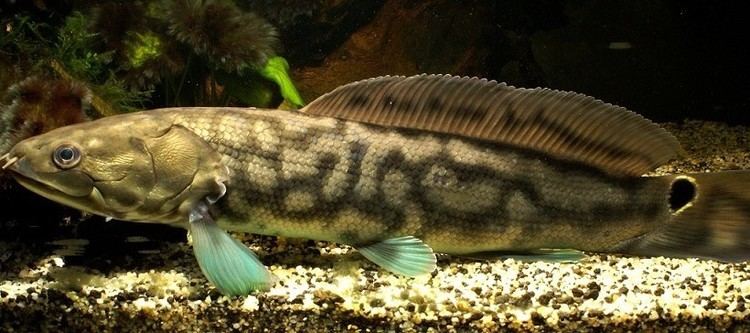 | ||
Similar Gar, Longnose gar, Amiidae, Paddlefish, Holostei | ||
How to catch bowfin dogfish fishing in new jersey
Bowfin (Amia calva) are basal bony fishes related to gars in the infraclass Holostei. Common names include mudfish, mud pike, dogfish, griddle, grinnel, cypress trout and choupique. They are regarded as taxonomic relicts, being the sole surviving species of the order Amiiformes which dates from the Jurassic to the Eocene, persisting to the present. Although bowfin are highly evolved, they are often referred to as "primitive fishes" because they have retained some morphological characteristics of their early ancestors.
Contents
- How to catch bowfin dogfish fishing in new jersey
- Bowfin attack
- Morphology
- Fishes similar in appearance
- Physiology
- Evolution and phylogeny
- Infraclass Neopterygii
- Genome evolution
- Feeding behavior
- Distribution and habitat
- Stocking
- Preferred habitat
- Life cycle
- Diseases
- Utilization
- Accumulation of toxic substances
- References
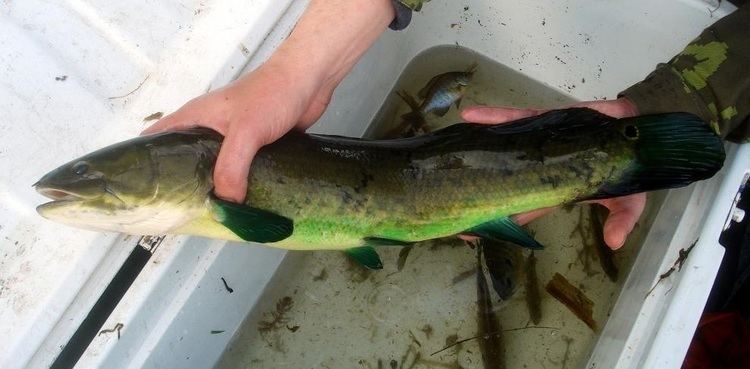
Bowfin are demersal freshwater piscivores native to North America, and commonly found throughout much of the eastern United States, and in southern Ontario and Quebec. Fossil deposits indicate Amiiformes were once widespread in both freshwater and marine environments with a range that spanned across North and South America, Europe, Asia and Africa. Now their range is limited to much of the eastern United States and adjacent southern Canada, including the drainage basins of the Mississippi River, Great Lakes and various rivers exiting in the Eastern Seaboard or Gulf of Mexico. Their preferred habitat includes vegetated sloughs, lowland rivers and lakes, swamps and backwater areas; they are also occasionally found in brackish water. They are stalking, ambush predators known to move into the shallows at night to prey on fish and aquatic invertebrates such as crawfish, mollusks, and aquatic insects.
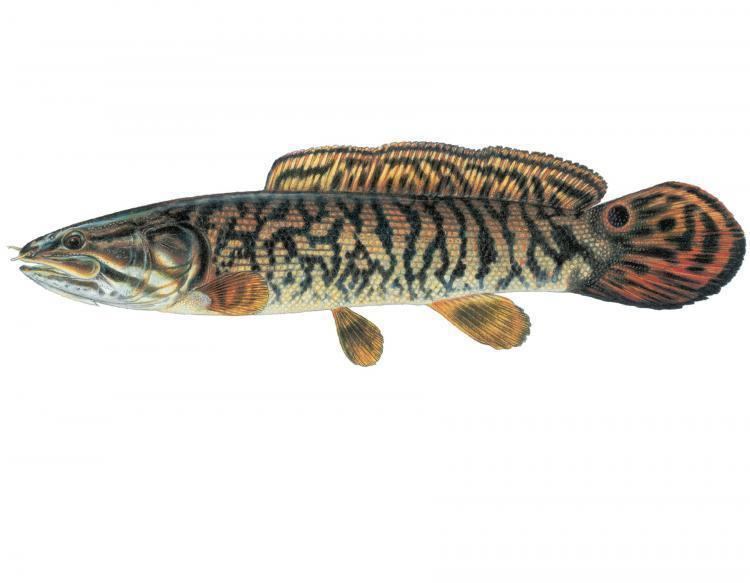
Like gars, bowfin are bimodal breathers which means they have the capacity to breathe both water and air. Their gills exchange gases in the water allowing them to exploit oxygen for breathing, but they also have a gas bladder that serves to maintain buoyancy, and also allows them to breathe air by means of a small pneumatic duct connected from the foregut to the gas bladder. They can break the surface to gulp air, which allows them to survive conditions of aquatic hypoxia that would be lethal to most other species.
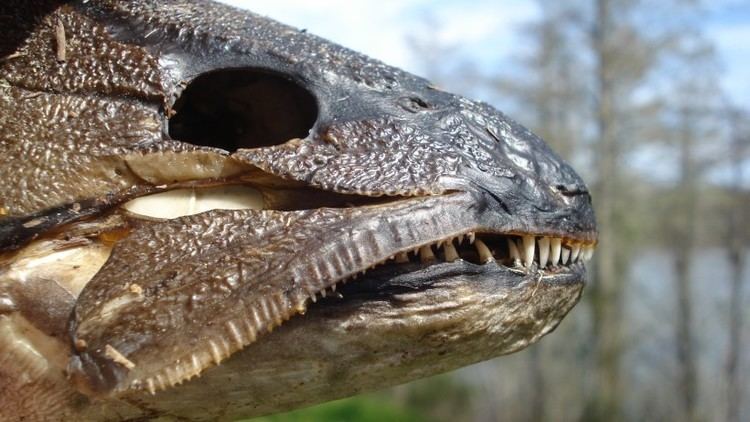
Bowfin attack
Morphology
The average length of a bowfin is 50 cm (20 in); females typically grow to 65–70 cm (26–28 in), males to 50–65 cm (20–26 in). Records indicate bowfin can reach 109 cm (43 in) in length, and weigh 9.75 kg (21.5 lb). Young of the year typically grow to 13–23 cm (5.1–9.1 in) by October. Females tend to grow larger than males.
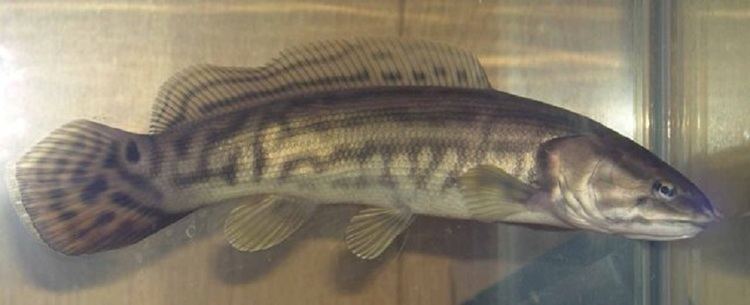
The body of the bowfin is elongated and cylindrical, with the sides and back olive to brown in color, often with vertical bars, and dark reticulations, or camouflaged pattern. The dorsal fin has horizontal bars, and the caudal fin has irregular vertical bars. The underside is white or cream, and the paired fins and anal fin are bright green. During larval stage, hatchlings from about 7–10 mm (0.28–0.39 in) total length are black and tadpole-like in appearance. At approximately 25 mm (0.98 in) total length they have been described as looking like miniature placoderms. They grow quickly, and typically leave the nest within 4 to 6 weeks after hatching. Young males have a black eyespot on the base of the tail (caudal peduncle) that is commonly encircled by an orange-yellowish border while the female's is black, if present at all. It is thought the purpose of the eyespot is to confuse predators, deflecting attacks away from the head of the fish to its tail, which affords the bowfin an opportunity to escape predation. The bowfin is so named for its long, undulating dorsal fin consisting of 145 to 250 rays, and running from the middle of the back to the base of the tail.

Bowfin are often referred to as "living fossils", or "primitive fishes" because they retained some of the primitive characters common to their ancestral predecessors, including a modified (rounded externally) heterocercal caudal fin, a highly vascularized gas bladder lung, vestiges of a spiral valve, and a bony gular plate. The bony gular plate is located underneath the head on the exterior of the lower jaw between the two sides of the lower jaw bone. Other distinguishing characteristics include long, sharp teeth, and two protruding tube-like nostrils. Unlike all of the most primitive actinopterygians, the scales of bowfin differ in that they are not ganoid scales, rather they are large, single-layered cycloid scales closer in similarity to more derived teleosts.
Fishes similar in appearance

Northern snakeheads (Channa argus) are commonly mistaken for bowfin because of similarities in appearance, most noticeably their elongated, cylindrical shape, and long dorsal fin that runs along their backs. Northern snakeheads are piscivorous fishes native to the rivers and estuaries of China, Russia, and Korea. However, unlike bowfin which are native to North America, the northern snakehead is considered an invasive species and environmentally harmful. Some contrasting differences in bowfin include a black eyespot on their caudal peduncle, a tan and olive coloration, a shorter anal fin, a more rounded head, and an upper jaw that is longer than its lower jaw.

The burbot, a predatory fish native to streams and lakes of North America and Eurasia, is also commonly mistaken for bowfin. Burbots can be distinguished by their flat head and chin barbel, long anal fin, and pelvic fins situated beneath the pectoral fins.
Physiology
Bowfin, like other physostomes such as bichirs (Polypteridae), gars (Lepisosteidae), and the lungfishes (Dipnoi), are capable of bimodal respiration. They can extract oxygen from the water when breathing through their gills, and can also break the water's surface to breathe or gulp air through a small pneumatic duct connected from their foregut to the gas bladder. When performing low-level physical activity, bowfin obtain more than half of their oxygen from breathing air. Bowfin have two distinct air-breathing mechanisms used to ventilate the gas bladder. Type I air breaths are consistent with the action of exhale-inhale stimulated by aerial or aquatic hypoxia to regulate O2 gas exchange; type II air breaths are by inhalation alone which is believed to regulate gas bladder volume for buoyancy control. Bimodal respiration helps bowfin survive and maintain their metabolic rate in hypoxic conditions. The rate of air breathing is higher in darkness, when the fish is more active.
Bowfin blood can adapt to warm, acidic waters. The fish becomes inactive in waters below 10 °C (50 °F); at this temperature they breathe almost no air; however, with increasing temperature their air breathing increases. Their preferred temperature range is between 12–26 °C (54–79 °F), with 18 °C (64 °F) the temperature of maximum activity. Air breathing is at a maximum in the range 18.4–29.6 °C (65.1–85.3 °F).
Herpetologist Wilfred T. Neill, reported in 1950 that he unearthed a bowfin aestivating in a chamber 4 inches (10 cm) below the ground surface, 8 inches (20 cm) in diameter, .25 miles (0.4 km) from a river. It was further noted that flood levels had previously reached the area, and receded. It is not unusual for riverine species like bowfin to move into backwaters with flood currents, and become trapped when water levels recede. While aestivation is anecdotally documented by multiple researchers, laboratory experiments have suggested instead that bowfin are physiologically incapable of surviving more than three to five days of air exposure. However, no field manipulation has been performed. Regardless of the lack of evidence confirming the bowfin's ability to aestivate, it has been noted that bowfin can survive prolonged conditions of exposure to air because they have the ability to breathe air. Their gill filaments and lamellae are rigid in structure which helps prevent the lamellae from collapsing and aids gas exchange even during air exposure.
Evolution and phylogeny
Competing hypotheses and debates continue over the evolution of Amia and relatives, including their relationship among basal extant teleosts, and organization of clades. Bowfin are the last remaining member of Halecomorphi, a group that includes many extinct species in several families. Halecomorphs were generally accepted as the sister group to Teleostei but not without question. While a halecostome pattern of neopterygian clades was produced in morphology-based analyses of extant actinopterygians, a different result was produced with fossil taxa which showed a monophyletic Holostei. Monophyletic Holostei were also recovered by at least two nuclear gene analyses, in an independent study of fossil and extant fishes, and in an analysis of ultraconserved genomic elements.
The extant ray-finned fishes of the subclass Actinopterygii include 42 orders, 431 families and over 23,000 species. They are currently classified into two infraclasses, Chondrostei (holosteans) and Neopterygii (teleost fishes). Sturgeons, paddlefish, bichirs and reed fish comprise the thirty-eight species of chondrosteans, and are considered relict species. Included in the over 23,000 species of neopterygians are eight relict species comprising gars and the bowfin.
Infraclass Neopterygii
Neopterygians are the second major occurrence in the evolution of ray-finned fishes and today include the majority of modern bony fish. They are distinguished from their earlier ancestors by major changes to the jaws, shape of the skull, and tail. They are divided into three divisions:
Genome evolution
The bowfin genome contains an intact ParaHox gene cluster, similar to the bichir and to most other vertebrates. This is in contrast, however, with teleost fishes, which have a fragmented ParaHox cluster, probably because of a whole genome duplication event in their lineage. The presence of an intact ParaHox gene cluster suggests that bowfin ancestors separated from other fishes before the last common ancestor of all teleosts appeared. Bowfin are thus possibly a better model to study vertebrate genome organization than common teleost model organisms such as zebrafish.
Feeding behavior
Bowfin are stalking, ambush predators that customarily move into the shallows at night to prey on fish, and aquatic invertebrates such as crawfish, mollusks, and aquatic insects. Young bowfin feed mostly on small crustaceans, while adults are mostly piscivorous, but also known to be opportunistic. Bowfin are remarkably agile, can move quickly through the water, and they have a voracious appetite. Their undulating dorsal fin propels them silently through the water while stalking their prey. The attack is straight forward and swift with a movement that lasts approximately 0.075 seconds.
Distribution and habitat
Fossil deposits indicate amiiforms included freshwater and marine species that were once widely distributed in North America, South America, Eurasia and Africa. Today, bowfin (Amia calva) are the only remaining species in the order Amiiformes; they are demersal freshwater piscivores, and their range is restricted to freshwater environments in North America, including much of the eastern United States and adjacent southern Canada from the St. Lawrence River and Lake Champlain drainage of southern Ontario and Quebec westward around the Great Lakes in southern Ontario into Minnesota. Historically, their distribution in North America included the drainage basins of the Mississippi River from Quebec to northern Minnesota, the St. Lawrence-Great Lakes, including Georgian Bay, Lake Nipissing and Simcoe, Ontario, south to the Gulf of Mexico; Atlantic and Gulf Coastal Plain from the Susquehanna River drainage in southeastern Pennsylvania to the Colorado River in Texas.
Stocking
Research from the late 1800s to the 1980s suggests a trend of intentional stockings of non-indigenous fishes into ponds, lakes and rivers in the United States. At that time, little was known about environmental impacts, or long-term effects of new species establishment and spread as a result of "fish rescue and transfer" efforts, or the importance of nongame fishes to the ecological balance of aquatic ecosystems. Introductions of bowfin to areas they were considered a non-indigenous species included various lakes, rivers and drainages in Connecticut, Illinois, Iowa, Kansas, Kentucky Maryland, Massachusetts, Missouri, New Jersey, New York, North Carolina, Pennsylvania, Virginia, West Virginia, and Wisconsin. Many of the introductions were intentional stockings by various resource management; however, there is no way to positively determine distribution resulting from flood transfers, or other inadvertent migrations. Bowfin are typically piscivorous, but as an introduced species are capable of being voracious predators that pose a threat to native fishes and their prey.
Preferred habitat
Bowfin prefer vegetated sloughs, lowland rivers and lakes, swamps, backwater areas, and are occasionally found in brackish water. They are well camouflaged, and not easy to spot in slow water with abundant vegetation. They often seek shelter under roots, and submerged logs. Oxygen-poor environments can be tolerated because of their ability to breathe air.
Life cycle
Bowfin spawn in the spring or early summer, typically between April and June, more commonly at night in abundantly vegetated, clear shallow water in weed beds over sand bars, and also under stumps, logs, and bushes. Optimum temperatures for nesting and spawning range between 16–19 °C (61–66 °F). The males construct circular nests in fibrous root mats, clearing away leaves and stems. Depending on the density of surrounding vegetation there may be a tunnel-like entrance at one side. The diameter of the nests commonly range between 39–91 cm (15–36 in), at a water depth of 61–92 cm (24–36 in).
During spawning season, the fins and underside of male bowfin often change in color to a bright lime green. The courtship/spawning sequence lasts one to three hours, and can repeat up to five times. Courtship begins when a female approaches the nest. The ritual consists of intermittent nose bites, nudges, and chasing behavior by the male until the female becomes receptive, at which time the pair lie side by side in the nest. She deposits her eggs while he shakes his fins in a vibratory movement, and releases his milt for fertilization to occur. A male often has eggs from more than one female in his nest, and a single female often spawns in several nests.
Females vacate the nest after spawning, leaving the male behind to protect the eggs during the eight to ten days of incubation. A nest may contain 2,000 to 5,000 eggs, possibly more. Fecundity is usually related to size of the fish, so it isn't unusual for the roe of a large gravid female to contain over 55,000 eggs. Bowfin eggs are adhesive, and will attach to aquatic vegetation, roots, gravel, and sand. After hatching, larval bowfin do not swim actively in search of food. During the seven to nine days required for yolk-sac absorption, they attach to vegetation by means of an adhesive organ on their snout, and remain protected by the parent male bowfin. Bowfin aggressively protect their spawn from the first day of incubation to a month or so after the eggs have hatched. When the fry are able to swim and forage on their own, they will form a school and leave the nest accompanied by the parent male bowfin who slowly circles them to prevent separation.
Bowfin reach sexually maturity at two to three years of age. They can live ten to twelve years in the wild, and 30 years in captivity. Females are longer-lived than males.
Diseases
A common parasite of bowfin is the anchor worm (Lernaea). These small crustaceans infest the skin and bases of fins, with consequences ranging from slowed growth to death. The mollusk Megalonaias gigantea lays eggs in the bowfin gills, that are then externally fertilized by sperm passing in the water flow. The small glochidia larvae then hatch and develop in the gill tubes.
Bowfin with liver cancer and with fatal leukemia have been reported.
Utilization
As a sport fish, bowfin are not considered desirable to many anglers. They were once considered a nuisance fish by anglers and early biologists who believed the bowfin's predatory nature was harmful to sport fish populations. As a result, efforts were taken to reduce their numbers. Research has since proven otherwise, and that knowledge together with a better understanding of maintaining overall balance of ecosystems, regulations were introduced to help protect and maintain viable populations of bowfin. Bowfin are strong fighters, a prized trait in game fish. However, they do have a jaw full of sharp teeth which requires careful handling. The current tackle record is 21.5 lb (9.8 kg)
Bowfin were once considered to have little commercial value because of its poor tasting meat which has been referred to as "soft, bland-tasting and of poor texture". However, it is considered quite palatable if cleaned properly and smoked, or prepared fried, blackened, used in courtbouillion, or in fishballs or fishcakes. Over the years, global efforts have imposed strict regulations on the international trade of caviar, particularly on the harvest of sturgeons from the Caspian Sea where the highly prized caviar from the beluga sturgeon originates. The bans imposed on Caspian sturgeons have created lucrative markets for affordable substitutes in the United States including paddlefish, bowfin, and various species of sturgeon. In Louisiana, bowfin are harvested in the wild, and cultured commercially in hatcheries for their meat and roe. The roe is processed into caviar, and sold as "Cajun caviar", or marketed under the trade name "Choupiquet Royale".
Accumulation of toxic substances
In some areas of the United States where aquatic environments have tested positive for elevated levels of toxins, such as mercury, arsenic, chromium, and copper, there are posted signs with warnings about the consumption of fish caught in those areas. Concentration of mercury biomagnifies as it passes up the food chain from organisms on lower trophic levels to apex predators. It bioaccumulates in the tissues of larger, long-lived predatory fishes. When compared to smaller, short-lived fishes, bowfin tend to concentrate mercury at higher levels thereby making them less safe for human consumption.
